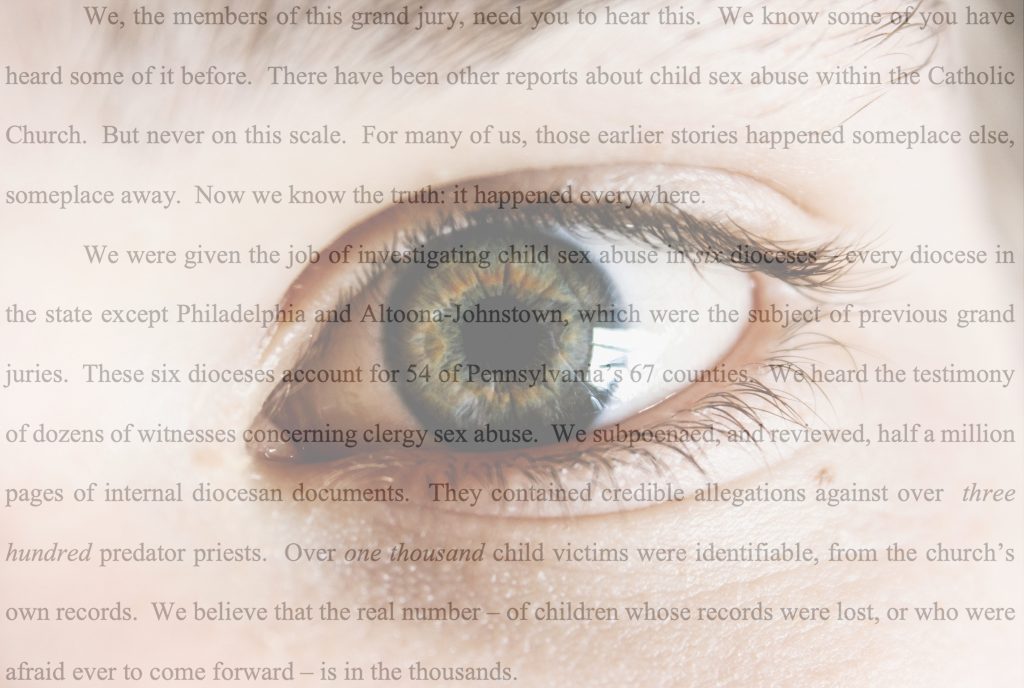In August of last year, Catholics in this country absorbed the shock of the Pennsylvania Attorney General’s grand jury report on clergy sexual abuse. The document was horrifying for the numbers it cited — hundreds of clergy perpetrators over six dioceses — and for its detailed descriptions of abusive acts.
It created the strong and repugnant impression that the ranks of the clergy were teeming with abusers, that the situation was constant for 70 years, and that bishops responded with cover-ups and little else.
This storyline, spelled out in the report’s opening pages, was repeated uncritically by media outlets for months.
Only in January did Peter Steinfels, a former religion reporter for The New York Times, produce a detailed critical analysis of the grand jury report.
In the pages of Commonweal magazine, Steinfels questioned the report’s narrative and called for “very fact-based, hard-hitting critical report of aspects of the Church’s response to credible (clergy abuse) allegations over a period of time.”
Well, there is no shortage of facts available to us. The Pennsylvania report itself is filled with facts, though they’re diffuse and subordinated to lurid stories.
I’ve spent the last several months drawing out the data that’s buried in the report and tried to present it in some coherent form. I have done so, in great detail, on my website. Here I’d like to present just a few of the facts I uncovered.
I’ve been a practicing psychiatrist since 1975. I attended Harvard Medical School, trained in psychiatry at Harvard, and then I worked and taught at Harvard for seven years. Afterward I joined the faculty and staff at the University of Pittsburgh for another 12 years before going into private practice.
Here’s a surprise for you: In all my years of training and beyond, I never heard a lecture on child abuse, and I evaluated only one abuser. He had been abusing his 8-year-old daughter, according to court documents, and was at our clinic only because he’d been ordered to go there. I saw him for a few sessions, then he quit coming.
There was nothing more to be done. The court lost interest, there was no equivalent to Child and Youth Services that had authority to investigate or mandate treatment, there was no continuing police involvement, and neither I nor my supervisors had any experience in this area or had any power to follow up on the case.
Also, none of us understood the depth of trauma that sexual abuse could cause.
Sigmund Freud was partially to blame. When he was starting out as a psychiatrist, he thought many of his patients had suffered sexual abuse as children — a belief that brought down much scorn upon him.
Later, he concluded that reports of abuse were fantasies, the product of the strong emotional conflicts that all children experience. As a result, this view was taught by most of the psychoanalysts who dominated the field into the 1970s.
Psychiatry was, in this sense, little different from other institutions in society. There was no clear consensus about how to deal with cases of child sexual abuse.
And as FBI agent and sex crimes expert Kenneth Lanning said at a Department of Justice symposium on child sexual abuse in 1984, “the most common response is denial; the refusal to accept it, the refusal to receive it, the refusal to process it.”
What else do we know, today, from the data presented in the report? Here are just a few samples.
While the report leaves the impression that abusive priests were numerous, that’s not the case. In Pittsburgh at least, the percentage of priests who abused in any given year exceeded 0.5% in only four years.
The peak year was 1.1 percent in 1980, and the next highest were 0.9 percent and 0.8 percent. In all other years examined, abusers made up fewer than half a percent of the priests in the diocese. That means that, in the worst year, 99 percent of priests were not abusing.
There was, moreover, after the peak, a sheer drop in the incidence of abuse. The report shows a high of 11 abusers among the Pittsburgh clergy in 1980, and from there the numbers dropped immediately and precipitously, reaching two in 1990 and then zero in 1997. In almost 20 years since 2000 there have been four abusers documented.
The period of peak abuse seems to have been an anomaly not only in the life of the Church, but also in the lives of many of the abusers. Of the 25 clergy in the Pittsburgh Diocese who abused during 1978-1982, only six did so again after 1990, and only one after 2000 (that abuse was committed in Thailand; the man was convicted and imprisoned in 2014).
Studying the abusers by ordination year also reveals some interesting patterns and occasional concentrations. Pittsburgh had four years that included four or more eventual abusers: 1963, 1964, 1970, and 1974.
Of the 266 reported incidents in Pittsburgh, 122 involved priests from these years. It is noteworthy that over the years that followed there are no similar concentrations of abusers. Since 1980 there have been four eventual abusers of 202 men ordained, and these were in scattered years.
We can say, furthermore, that the numbers have become even more reliable as time goes on. Most of the abuse that happened in the 1960s didn’t come to light till the 2000s.
But since 1988 the average time between abuse and reporting has steadily decreased, from 30 years to zero-five years since 2000, for the few actual abuses since 2000. So, the decline of reported incidents is likely to be an accurate reflection of reality.
I propose that we not rush to judge every single person, both within the Catholic Church and among civil and helping professions, who tried to deal with the painfully difficult issues of sexual abuse at a time when those issues were misunderstood, often denied, greatly feared and widely avoided throughout society.
Let’s not kill the messengers who struggled to find appropriate action and policies. When the abuse cases of the early 1980s became public, some bishops and other clergy tried desperately to do the right thing, as I think they did in Pittsburgh, but they also were conditioned by the ignorance that prevailed among medical professionals and the confused relationship between Church and civil authorities.
If the Church’s early responses to the problem of child sexual abuse were flawed, it was likely often because there was general confusion in many professions — law enforcement, the courts, and psychiatry — about how to deal with victims and perpetrators.
The Pittsburgh Diocese was an early responder, forming an advisory committee on which I was invited to serve in 1992. I can testify that concrete actions followed from the Church’s self-examination.
Increased cooperation with the police and the judicial system has led to the prosecution of many abusers. Educational programs for seminarians, clergy, and laity have been instituted and mandated for every person who has contact with children — from fish-fry volunteers and catechists to ushers and choir directors.
The abuse of children by clergy is an undeniable horror, and it never should have happened. It is natural for us to feel angry when we hear of it. Anger is the passion that drives us to seek and win justice. But we cannot overcome the problem — and we cannot achieve justice — if we don’t see the matter clearly.
Dr. John P. Nelson, who practices in Pittsburgh, Pennsylvania, has 51 years of experience. His specialties include psychiatry and neurology.

